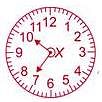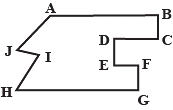Test: Lines, Angles & Triangles - 1 - Class 5 MCQ
10 Questions MCQ Test Mathematics for Class 5 - Test: Lines, Angles & Triangles - 1
How many of the following figures have parallel lines?


Four pupils each made a statement about the given figure.

Jyoti : "I can see 6 pairs of perpendicular lines".
Harsha: "There are 7 angles in the figure".
Jiya : "There is only one pair of parallel lines".
Harsh : "6 of the angles are less than a right angle".
Which pupil make the correct statement?

Jyoti : "I can see 6 pairs of perpendicular lines".
Harsha: "There are 7 angles in the figure".
Jiya : "There is only one pair of parallel lines".
Harsh : "6 of the angles are less than a right angle".
Which pupil make the correct statement?
| 1 Crore+ students have signed up on EduRev. Have you? Download the App |
How many of the given letters have perpendicular lines?


The clock shows the time in the morning. ∠X represents ____ angle.

At 3:25, the smaller angle formed between the two hands of a clock is ____.
There are six angles below. How many of them are greater than a right angle?

Which of the following is greater than a right angle?
An angle which measures more than 90∘ but less than 180∘ is called_____.
|
58 videos|122 docs|40 tests
|
|
58 videos|122 docs|40 tests
|




















